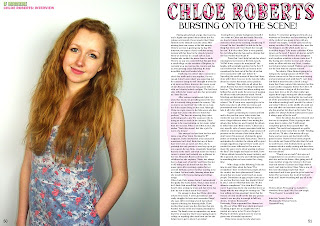Looking back at your preliminary task, what do you feel you have learnt in the progressing from it to the full product?
- Main: The ability to use softwear better. At the begining (my preliminary task) my photoshop skills were limited and the product I created wasn't very good. After practice and tutorials on photoshop, I managed to use a variety of different tools in order to make the product look more professional
- Preliminary Task
Final Product
- It is clear to see where my skills have changed and developed from start to end as the final product looks a lot more professional and more aestetically pleasing to the target audience
- From doing my preliminaries I have also learned to use different technologies such as cameras, lighting equipment and, of course, Photoshop. Using these I increased my knowledge as to how magazines are made and also how to use skills I have gained in order to create a product that looks professional and authentic
- On my final product I used a variety of different tools and effects which I worked out how to use which makes the product look a lot more professional in comparisson to my preliminary work
- In comparisson to my prelim, the way I have edited the cover to make it look more professional as I have done a lot of research to realise how the magazine should look. When doing the preliminary work I hadn't done any research into magazine conventions and I belive that this has helped me to create a better product overall
- An example of this is using exposure and contrasting in order to make the image more striking and to make the magazine stand out more to readers. Before, the colours which I used were very simple and understated meaning that it looked fairly boring. I believe that the cover of my magazine is very eye catching and is attractive to the intended audience (as opposed to my prelim which was supposed to be aimed at students who may not have been attracted to the magazine)
- I also believe that I have have become more efficient with using the technologies, for example I am a lot quicker at completeing tasks on Photoshop and have a wider undertanding of how to use it as well as developing skills.
- My understanding of the way which magazines are created has improved as during the research and planning I looked into magazines. This involved analysis of covers, contents pages and double page spreads. This helped me to understand the conventions of magazines and helped me to realise how I needed to layout my magazine
- Double page spread

- The double page spread shows using techniques such as exposure, shadows, text allignment, creating patterns within text, etc
- I also realised the techniques, features and conventions used in order to appeal to a chosen audience. Features such as the golden spiral for photographs as it controls the readers focus on the page as well as being able to make the page aesthetcially pleasing to the target reader.
- My knowledge grew further during planning when I was creating drawn plans and computer versions of the plan. Working out where everything would look best and what i wanted it to look like overall was challenging however with time and practice I became a lot more aware of the layout of my magazine and how i wanted to make it look. This then helped me achieve my final product
- Contents pages
- Showing the contents pages from my preliminary work and my final project it is clear to see the differences as I have developed my skills on photoshop
- First of all I believe that the final contents page is more suited to my target audience as I think that they will relate more to the images, text and layout/overall look of the page
- i think that my preliminary work is quite boring and does not relate well to the target audience of school students as they will be more likely to want to look at something exciting and fun (full of pictures, text, stories, etc) and therefore doesnt fit the target audience well
- Also the layout looks more professional. The final design shows that I have researched carefully into the way which magazine contents pages have been layed out in real magazines. I did this in order to achieve an authentic looking magazine contents page and I feel that with a few tweaks it could look very professional and authentic
- The preliminary layout wasn't unprofessional or scatty, it was neat which was good as it was clear for the audience to read however the neatness made it look really boring and therefore not good enough to be considered a real magazine
- I have learnt that using images of better quality (and using the right people!) ensure a more professional and genuine look to the magazine. Using the camera and other equipment that the school provided I managed to create good quality images to use throughout my magazine in order to ensure that the magazine looked as good, high end and professional as possible
From looking at the cover of my magazines, development in skills and ideas is clearly shown. The more professional (neater) layout and the more relevant topics shows development in my understanding of the concept and target audience as well as developing skills in taking photographs and using technology (Photoshop) in order to bring my product together and have continuity throughout




a superb answer.
ReplyDelete